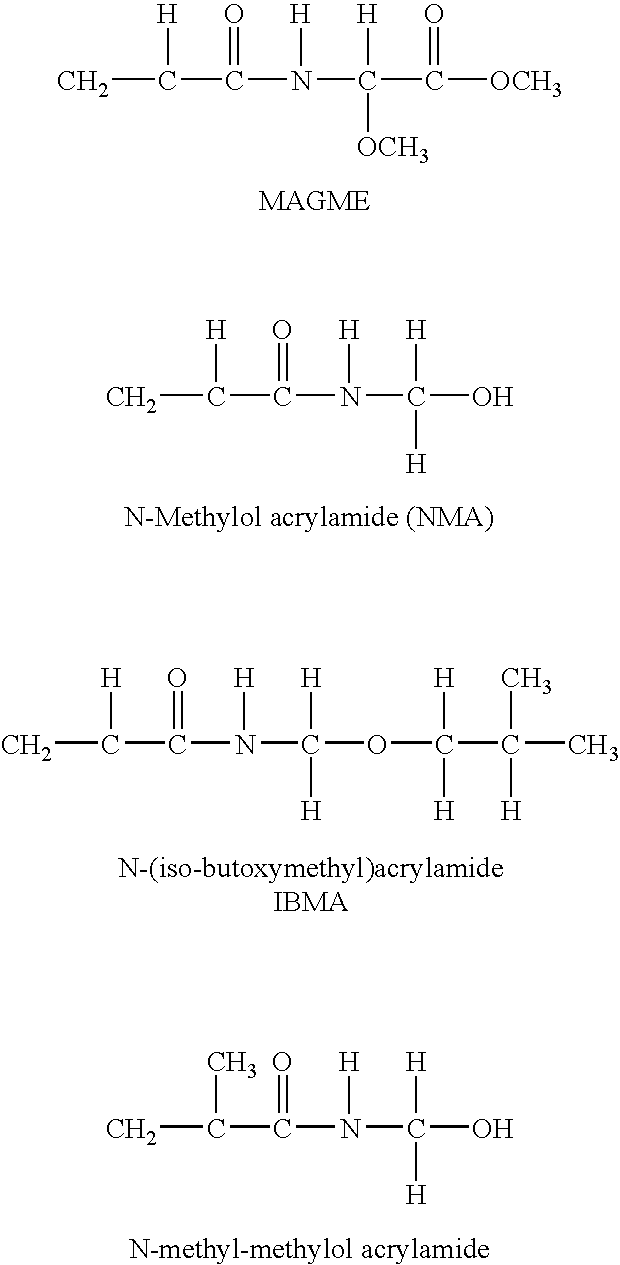Method of production of veneer assembly
- Summary
- Abstract
- Description
- Claims
- Application Information
AI Technical Summary
Problems solved by technology
Method used
Image
Examples
example 1
[0060] The high Tg acrylic polymer component used in the preferred thermocurable adhesive of the present invention (comprised of 40% by wt. .t-butyl methacrylate, 10% by wt. butyl acrylate, 20% by wt. N-vinyl-2-pyrrolidone and 30% by wt.glycidyl methacrylate) was formed in ethyl acetate solvent using a free radical initiator to a molecular weight of approximately 200,000 GPC relative to polystyrene and having a first pass glass transition temperature (Tg) of about +60.degree. C. DSC and a second pass glass transition temperature (Tg) of approximately +90.degree. C. DSC.
example 2
[0061] A thermocurable pressure sensitive adhesive composition suitable for use in the present invention was formed in the following manner. A base pressure sensitive adhesive marketed by Ashland under the designation A1044 (comprised of a vinyl acetate modified acrylate pressure sensitive adhesive containing an acid functionality) was admixed with the high Tg polymer of Example 1 comprised of the reaction product of 40% by wt. t-butyl methacrylate, 10% by wt. butyl acrylate, 20% by wt. N-vinyl-2-pyrrolidone and 30% by wt. glycidyl methacrylate) and a reactive unsaturated polyester tackifier resin together with a dipropylene glycol diacrylate crosslinking agent (Laromer UP 35D). A free radical initiator was also present, being either a peroxide or azo initiator. The resulting adhesive composition in the form of a 1 mil thickness film exhibits 1-4 lbs / inch of peel adhesion, and holds 500 grams in a static shear for 30-2000 minutes.
example 3
[0062] The pressure sensitive adhesive of Example 2 was transfer coated onto a phenolic modified elastomer coated paper and used to join adjacent pieces of veneer together by application to the joint between the adjacent pieces along the surface of the veneer. Upon removal of the paper, the combination of the phenolic modified elastomer coating and the adhesive had sufficient strength to hold the veneer pieces together during subsequent handling. The veneer was bonded to the particle board core using a urea formaldehyde adhesive commonly used in the industry. When pressed at 250.degree. F. and 150 psi for 120 seconds, the resulting pieces of veneer are bonded together.
PUM
| Property | Measurement | Unit |
|---|---|---|
| Percent by mass | aaaaa | aaaaa |
| Percent by mass | aaaaa | aaaaa |
| Pressure | aaaaa | aaaaa |
Abstract
Description
Claims
Application Information
 Login to View More
Login to View More - R&D Engineer
- R&D Manager
- IP Professional
- Industry Leading Data Capabilities
- Powerful AI technology
- Patent DNA Extraction
Browse by: Latest US Patents, China's latest patents, Technical Efficacy Thesaurus, Application Domain, Technology Topic, Popular Technical Reports.
© 2024 PatSnap. All rights reserved.Legal|Privacy policy|Modern Slavery Act Transparency Statement|Sitemap|About US| Contact US: help@patsnap.com








